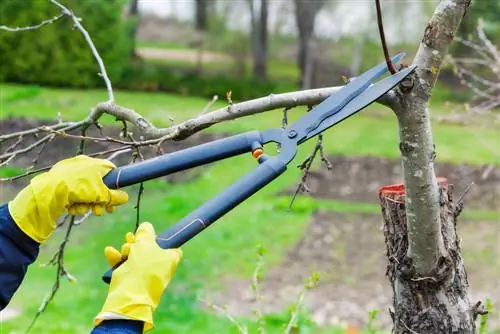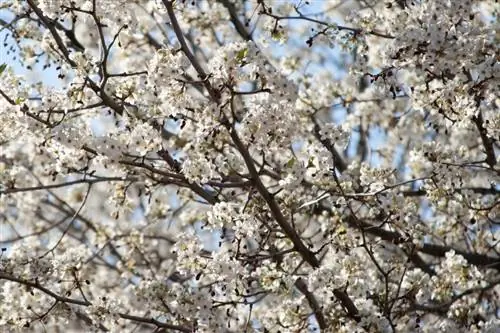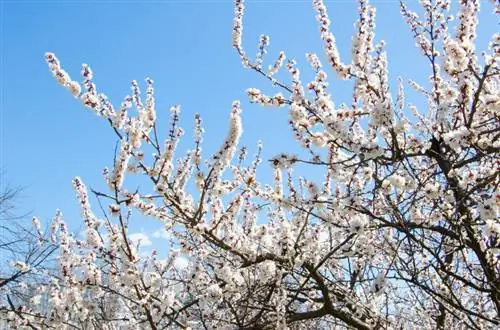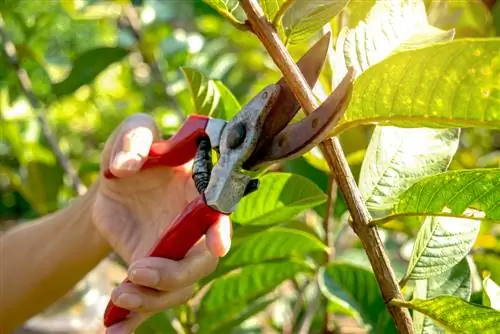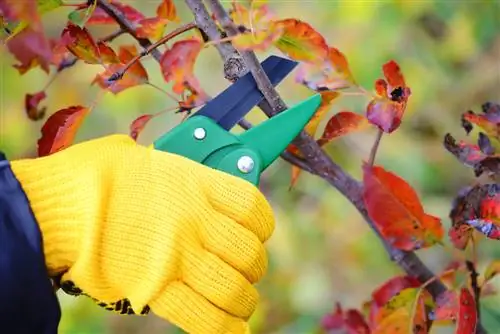- Author admin [email protected].
- Public 2024-01-31 08:49.
- Last modified 2025-06-01 06:02.
When it comes to pruning trees, it is of course not enough to simply grab the scissors and start cutting. But not only the how, but also the when is relevant - pruning at the wrong time leads to an unwanted reaction or even a high risk of illness.

When is the best time to prune a tree?
Trees should ideally be cut during the growing season between March and September, as they can heal wounds more quickly during this phase and the risk of infection is lower. Winter pruning can promote growth, while summer pruning tends to slow growth.
In the past, trees were usually cut in late autumn or early spring - during winter dormancy. Today, however, tree care experts recommend doing pruning work during the growing season between March and September.
Why?Summer cutting is gentler, wound healing begins immediately and there is no risk of frost damage to the wound site. Nevertheless, pruning during winter dormancy has somefew advantages over pruning during the growing season.
Winter pruning: tree pruning in late autumn/winter/spring
Since ancient times, deciduous trees and other summer green trees have been cut in early spring or late winter. A cut in suitable weather in January or February - well before budding - also has advantages:
- No leaves and therefore fewer nutrients are removed, which means the tree is weakened less.
- Due to the lack of foliage, it is easier to see where to cut
- Winter pruning stimulates increased sprouting in spring, as the reserve substances of all the leaves have already been stored and after pruning more energy is stored in the roots for fewer buds.
- Disadvantage: At temperatures<0°C after the cut, the frost can penetrate into the now open area and damage to the branch or tree can occur.
Winter pruning brings one thing above all else - wood growth. If I cut my young fruit trees that are still growing vigorously, this must of course be done in late autumn or February at the latest. If I cut my 15-year-old maple tree, which is already getting too big for me, I should definitely do this in the summer to remove leaves and not stimulate further growth.
Summer pruning: tree pruning in summer/autumn
In tree care, there is now a tendency to prune during the growing season. The tissues are already active and the “healing” (sealing off and covering) of the wounds begins immediately. In addition, the cut trees react less strongly with new shoots; “water shoots”, which are of no value for crown development, occur much less frequently. Advantages of summer cutting:
- The tree is still in the middle of growth and can therefore close wounds more quickly.
- Many fungal pathogens are particularly active in late winter/spring, which is why infection is more likely then.
- You have a better view of which branches are taking away too much light and therefore need to be removed.
- Early thinning provides the tree with plenty of light and air before the winter break.
- There are no possible frosts that could further weaken the freshly cut tree.
- Growth is not additionally stimulated because leaf mass is removed - reactions to the cut (shoots of water, unwanted strong and numerous shoots) are less strong and chaotic.
- Growth is slowed down the most if you cut as soon as it shoots - but this also weakens the tree the most.
The summer cut extends from March to the end of September. In principle, you can always cut during this period, but there are certain unfavorable situations:
- Midsummer: In July, when it is particularly hot, it is not advisable to cut too hard. Parts of the crown (bark) that are normally in the shade are suddenly exposed to the direct mid-summer sun. “Sunburn” can occur, damage to the cambium and cracking of the bark. This is especially true for tree species with dark bark (e.g. cherry) or with very thin bark (e.g. common beech).
- Strong wind: If the trees are exposed to strong wind and weather events and parts of the crown are suddenly exposed to this wind and weather, for example by removing individual long branches, it can happen that they break more easily due to the release.
- Old, weakly budding tree species: Here you want to promote budding, so winter pruning is also acceptable.
Basically applies
Tree pruning is possible all year round, but you should know what you want to achieve. If you cut a tree in winter that you don't want to get any bigger, you can simply cut it again in summer. If you want to make major corrections to fruit trees, you should definitely do this in the summer, even if the tree is still growing. Here the cut is also divided into summer and winter.
Background: How does the tree react to the cut?
Trees don't heal their wounds - they seal them off. When cut, the tree reacts in the same way as a branch breaks; at the break or interface, the tissue inside is sealed off in such a way that neither air nor pathogens can penetrate deeper into the wood. The wood tissue that is separated from the he althy tissue by the insulation dies. In addition, the wound is closed again from the outside by an overflow. The wood tissue that is separated from the he althy tissue by the insulation dies. The correct incision now determines whether this process can proceed quickly and cleanly. In addition, there are bad and good “blockers” under the trees. If the tree does not manage to successfully seal off and overflow, the slow decay begins from the inside, as decomposing microorganisms can spread throughout the tree and penetrate ever deeper into it.
Research on the topic has shown that trees can carry out this process most efficiently during the growing season between March and September. If you cut during winter dormancy, larger areas of dead wood tissue will appear. If branches with a diameter that are too large are cut (>10cm or>5cm with poor “blockers”), the tree will not be able to create a secure barrier between he althy and dead wood tissue.

